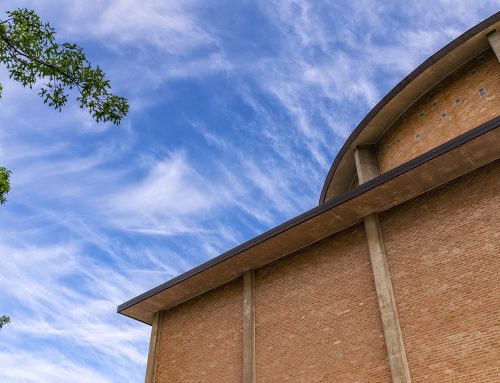Drive east on Lupton, in the block between Tulane and Edgemere, and you’ll miss it if you’re not looking for it. On the north side of the street, sitting almost ingenuously among the ranch homes that make up so much of Preston Hollow, is a two-story, prairie-style teardown.
The house, which seems more East Dallas than east of Preston Road, is set back from the street the same distance as its neighbors. A porch extends along the front of the house, and there are no arched roofs or two-story front entrances to be seen. It is certainly taller than the houses around it, but it doesn’t seem offensively so.
Is it possible this is a teardown that does the impossible – please its owners without driving the neighbors crazy?
“I’d like to think so,” says Nick Glazbrook, the architect who designed the house.
“I wanted to do a house that fit the neighborhood without copying the ranch house style. And those post-World War II ranch houses were inspired by the Prairie style, so I thought, why not do a Prairie-style house?”
And in one respect, Glazbrook is right. This is a teardown that doesn’t sport the brick facades and oversized floor plans that have too often made these homes unwelcome neighbors in our neighborhood. But whether this home, thoughtfully designed and constructed, can ease worries about the influx of teardowns in Preston Hollow is another matter.
“Teardowns are still considered a very serious problem in our neighborhood,” says Murphy Johnston, who tracks zoning and construction concerns for the Preston Hollow East Homeowners Association.
“But we still haven’t figured out what exactly we can do about it. There isn’t a lot anyone – us or the city – is allowed to do about it.”
Focusing on the issues / The debate over teardowns in Preston Hollow has been going on for years. Recently, the number of teardowns, by ZIP code, may have increased by as much as one-third a year. In some neighborhoods, there have been few. In others, teardowns – buying an older house, tearing it down, and building a bigger one in its place – pop up on the same couple of blocks two and three at a time.
Preston Hollow, with its spacious lots, older homes and choice location (south of LBJ and within minutes of downtown and North Dallas), lends itself to teardowns. Ask someone in 1990 why they lived in Preston Hollow, and their reply probably would have focused on the area’s atmosphere, large lots and the like. Ask someone today, say a variety of urban experts, and the answer is more likely to revolve around avoiding long commutes.
Hence teardowns, by their very nature, change the character of the neighborhoods that attract them.
“It just depends on your perspective,” says Virginia Tech’s Robert Lang, one of the country’s leading authorities on teardowns. “The people who do teardowns don’t see it the same way the neighbors do. They see a neighborhood they want to move into. The neighbors see it as someone moving in next door who is changing the way they live.”
Fortunately for our neighborhood, those differences haven’t yet been as acrimonious as they have been in some areas in the Park Cities or in East Dallas, especially in the M Streets. In the latter, an attempt to form a conservation district, which would use zoning to restrict teardowns, has engendered much ill will among residents for and against the proposal.
That’s because the objection in Preston Hollow is not so much over teardowns as a concept, but whether builders, architects and homebuyers can better execute teardowns to cause the least harm to neighborhood sensibilities. There aren’t the numbers of historical and near-historical homes here that there are in East Dallas, which means residents are more concerned with the practical aspects:
- Do the new houses match the others on the street? The difference often is subtle. Two teardowns near Glazbrook’s Prairie-style home, at the corner of Edgemere and Prestonshire, certainly don’t do much for the neighborhood, but should they have been forbidden? Lang, with a laugh, says much of the backlash against teardowns may be a reaction against wealthy people who are perceived to have poor taste.
- Is construction a problem for neighbors? Do workmen show up at 7 a.m. on Saturday or do trucks block driveways?
- Does new construction take into account older, less sophisticated building techniques? Some teardowns, Johnston says, can cause drainage problems for neighbors after heavy rains, since their lots weren’t designed to handle the runoff from bigger houses.
“There is no other way to do it than to make sure the design should attempt to fit into the neighborhood,” says Kathy Hampton, a builder who has done teardowns in Preston Hollow since the mid-’90s.
“That’s nothing other than being a good neighbor. It’s showing respect for the neighborhood in respect to hours, picking up trash and going the extra mile not to upset residents.”
Finding a middle ground / By some accounts, that doesn’t always happen. Johnston notes that trees, despite a city ordinance that mandates how and when they can be cut down, always seem to vanish during a teardown. That, he says, does not endear teardowns to neighbors.
“There is no question that compromise has to be the goal,” says Jim Lindberg of the National Historic Trust, who helped write the organization’s white paper on urban teardowns.
“Cities can’t remain the same forever. There has to be change and growth, but that change and growth should also respect the character of the neighborhood. That’s tough to do, but it can be done.”
Compromise, in this case, should recognize two things. First, teardowns are inevitable and will remain so as long as real estate prices make the math work and as long as home buyers continue to be willing to pay a premium to live in an area that Janice Hills of Ebby Halliday calls one of the hottest in the Metroplex.
“They’re buying location,” she says, “and the prices are unbelievable.”
A lot in Preston Hollow that’s suitable for a teardown can cost as much as $400,000. That translates into new homes worth $800,000 to $1 million, and despite the stumbling economy, there seems to be no end in sight.
Second, for a compromise to work, Dallas must be able to establish a system to manage teardowns, to handle the issues about trees and drainage. Says Lake Highlands’ Marcel Quimby, a member of the National Historic Trust’s board of directors and an architect who specializes in historic preservation: “It’s all about promoting dialogue, and it needs to start at the neighborhood level. Why do we live here, and what can we do to keep that?”
The answers to those questions, say urban experts, are the framework for a compromise. They say the framework includes everyone who is part of the process, from residents to Realtors to architects to builders to homebuyers. In Preston Hollow, where Johnston says residents haven’t talked much about a conservation district, less formal – but equally recognized – guidelines might be sufficient.
That means residents must accept teardowns as a fact of life, whether they like them or not. Realtors who work with teardowns must be forthcoming with potential buyers about neighborhood objections. Architects must take neighborhood sensibilities into account, even if they see those sensibilities as lacking. Builders must understand that residents have legitimate objections, be they trucks and workmen at 6 a.m. on Saturdays, fears about shoddy materials and workmanship, or the dreaded two-story front entrances. Buyers must make an extra effort to appreciate that their dream house might be someone else’s sleepless night.
The good news is that those tenets have already been discussed. The Dallas Homebuilders Association, which opposes any zoning restrictions such as conservation districts, might be amenable to style shopping lists, says spokesman Paul Caudouro. Builders would match features from the list with specific neighborhoods, and this might eliminate some of the more onerous practices.
In the nearby Lake Highlands neighborhood east of Central Expressway, where teardowns have yet to make much of an impact, one homeowners group says it’s considering guidelines to pass on the builders if and when teardowns come, detailing setbacks, height restrictions and the like. Lang’s non-profit, in fact, is looking for grant money to put together just such standards, and he hopes to start the project next year.
“That sort of approach is the most realistic way to do it,” says Philip Henderson, a Dallas architect who has handled several historic renovations.
“Some people just don’t understand why a contemporary house in a 1930s Tudor neighborhood might upset residents. If everyone can agree ahead of time, it takes the onus away, and you create a positive impact.”
The linchpin to any sort of compromise, though, must be the city – which is the bad news. Not only does almost everyone on every side of the issue agree about that, they also agree that Dallas, as things stand now, probably isn’t capable of undertaking the job. The council is divided, the city staff must walk a political tight rope between the various parties involved, and resources, never abundant for code enforcement sorts of services, are even more strained.
“Typically, in other cities, they work with neighborhoods in situations like this,” Quimby says. “In Dallas, we’re less restrictive about what can be done. We see planning more as a response to a crisis and not something that’s done ahead of time and acted on.”






